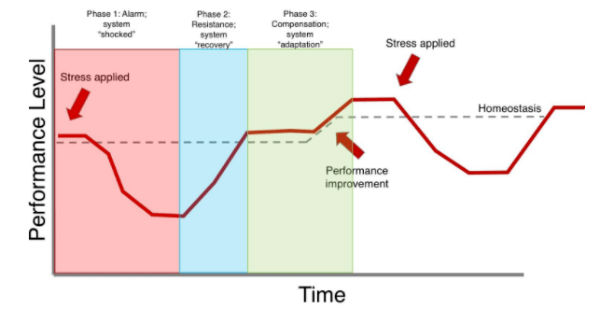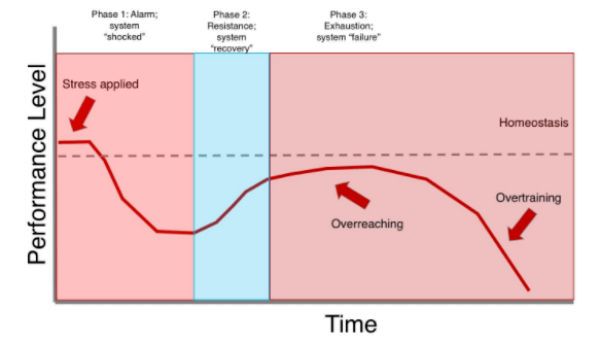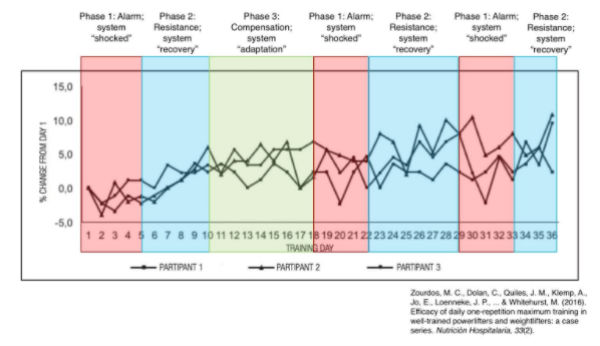
If we were forced to take a step back and reduce working out to its simplest form, we would be left with the concept of stress—that is, putting stress on your muscular system in order to cause adaptations (in this case more muscle and strength, and less fat).
Austrian Physicist Hans Selye is first credited with establishing the concept of General Adaption Syndrome. This refers to the body’s different phases that are set off by an outside stressor or stimulus (free weights or machines).
When a stress is first applied to the body, the system is shocked and a decrease in performance level occurs. Then, as the body becomes stronger to that given stimulus it eventually surpasses the level it was at previously. In the same way, as you lift weights and exercise, you will become stronger, more muscular, and leaner the more you provide an adequate stimulus to your body.

Han Selye’s Model of the General Adaptation Syndrome
But it’s really that one word that makes up the core of the issue: adequate stimulus. Without the proper stress, your body won’t adapt.
In the case of training, there is sure to be a scenario when you feel like you just aren’t making progress at the rate you should be.
Often times, the initial thought immediately becomes, “Am I overtraining?”
To be frank, a large majority of individuals have never been truly over trained, but instead have entered the edge of what is known as overreaching—a period of time in which your body is pushed slightly past its “edge”.

Overtraining occurs when the body has overreached for an extended period of time without recovering fully.
If planned beforehand intelligently, this overreaching aspect can be extremely powerful in making large new adaptations—more muscle and strength to bust through a plateau.
However, when most people reach this area, they prematurely back off for fear of injury.
To make the point beyond question, take a look at a case study intended to test the theory. It was generally modeled off of the Bulgarian method which calls for a 1-rep max every single day (normally in just 1 lift such as squat or bench), followed by back-down sets and reps.
For 37 days in a row, experienced lifters performed daily 1-rep squat max and then followed that up with an additional 5 sets—either sets of doubles at 90% of the daily max, or triples at 85% of the daily max.
Right off the bat, you may think this is a terrible and even ridiculous idea that would lead to not just poor results but even injury.
You wouldn’t be wrong. But you also wouldn’t really be right.
While it was an extensive and intense training protocol not suitable for beginners, it proved beyond impressive for those athletes with enough training maturity to complete it.
By the end of it, the average increase in 1RM was consistently 5-10% higher than at the beginning of the cycle. So for a 500 pound squatter, that is literally 25-50 pounds added to the bar in 5 weeks.

Results of the study conducted on experienced strength athletes.
These results are further backed by many proponents of Bulgarian training who swear by the out-of-this world results (if you already have a strong base from lifting for several years, it is very likely one 1-month cycle of this type of program could increase your total 100 pounds).
But before signing off on the study it is important to break it down and understand the different phases that took place.
When athletes first began the program, their performance suffered immediately—they had to fight ups and downs throughout the entire exercise program that lasted roughly 5-7 days.
However, by the second week every person had adapted to the new training and every person was higher than their initial baseline strength test on day one.
The main thing to be gathered from this is an immediate reaction to drop your workouts when they get tough probably isn’t the right answer—as we can see from this study, sticking it through those initial ups and downs when the going gets rough lead to powerful adaptations in the following days.
So don’t give up on your program as soon as it starts to hurt a little more than normal.
With that said, there is obviously a fine line between overreaching in a smart fashion such as this and going too far and getting yourself injured.
In order to help combat this possibility, it is also important to track subjective measures of stress and recovery. The most important of these is known as RPE (a chart explaining RPE can be seen here).
RPE—Rate of Perceived Exertion—is a subjective measure of how hard the weight feels on any given set. By tracking this on a log each time you lift, you can gain a deep insight into your actual progress over time.
For example, if you do 315 for 5 reps on squat two separate occasions, all things seem equal and you may feel that no progress was made—until you add in the RPE and see that your second day was easier than the first (because you wrote it down!).
One last time, it is very important to note that this style of lifting weights is suited towards advanced athletes. Those who are novice or intermediate lifters will still be able to make much progress on a far less aggressive program. With that said, for intermediate athletes it is best used sparingly as an aspect of your peaking protocol.
